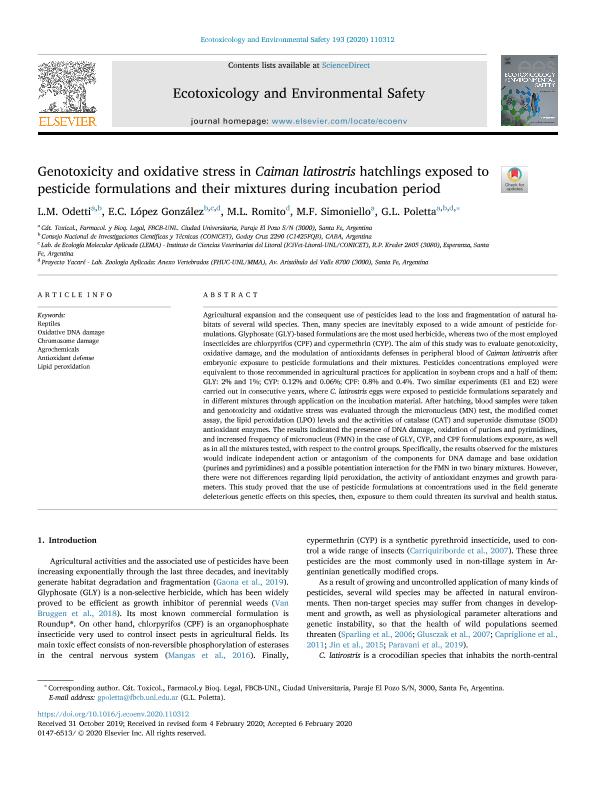Artículo
Genotoxicity and oxidative stress in Caiman latirostris hatchlings exposed to pesticide formulations and their mixtures during incubation period
Odetti, Lucia Magdalena ; López González, Evelyn Cecilia
; López González, Evelyn Cecilia ; Romito, María Laura; Simoniello, Maria Fernanda; Poletta, Gisela Laura
; Romito, María Laura; Simoniello, Maria Fernanda; Poletta, Gisela Laura
 ; López González, Evelyn Cecilia
; López González, Evelyn Cecilia ; Romito, María Laura; Simoniello, Maria Fernanda; Poletta, Gisela Laura
; Romito, María Laura; Simoniello, Maria Fernanda; Poletta, Gisela Laura
Fecha de publicación:
04/2020
Editorial:
Academic Press Inc Elsevier Science
Revista:
Ecotoxicology and Environmental Safety
ISSN:
0147-6513
Idioma:
Inglés
Tipo de recurso:
Artículo publicado
Clasificación temática:
Resumen
Agricultural expansion and the consequent use of pesticides lead to the loss and fragmentation of natural habitats of several wild species. Then, many species are inevitably exposed to a wide amount of pesticide formulations. Glyphosate (GLY)-based formulations are the most used herbicide, whereas two of the most employed insecticides are chlorpyrifos (CPF) and cypermethrin (CYP). The aim of this study was to evaluate genotoxicity, oxidative damage, and the modulation of antioxidants defenses in peripheral blood of Caiman latirostris after embryonic exposure to pesticide formulations and their mixtures. Pesticides concentrations employed were equivalent to those recommended in agricultural practices for application in soybean crops and a half of them: GLY: 2% and 1%; CYP: 0.12% and 0.06%; CPF: 0.8% and 0.4%. Two similar experiments (E1 and E2) were carried out in consecutive years, where C. latirostris eggs were exposed to pesticide formulations separately and in different mixtures through application on the incubation material. After hatching, blood samples were taken and genotoxicity and oxidative stress was evaluated through the micronucleus (MN) test, the modified comet assay, the lipid peroxidation (LPO) levels and the activities of catalase (CAT) and superoxide dismutase (SOD) antioxidant enzymes. The results indicated the presence of DNA damage, oxidation of purines and pyrimidines, and increased frequency of micronucleus (FMN) in the case of GLY, CYP, and CPF formulations exposure, as well as in all the mixtures tested, with respect to the control groups. Specifically, the results observed for the mixtures would indicate independent action or antagonism of the components for DNA damage and base oxidation (purines and pyrimidines) and a possible potentiation interaction for the FMN in two binary mixtures. However, there were not differences regarding lipid peroxidation, the activity of antioxidant enzymes and growth parameters. This study proved that the use of pesticide formulations at concentrations used in the field generate deleterious genetic effects on this species, then, exposure to them could threaten its survival and health status.
Archivos asociados
Licencia
Identificadores
Colecciones
Articulos(CCT - SANTA FE)
Articulos de CTRO.CIENTIFICO TECNOL.CONICET - SANTA FE
Articulos de CTRO.CIENTIFICO TECNOL.CONICET - SANTA FE
Articulos(ICIVET-LITORAL)
Articulos de INST. DE CIENCIAS VETERINARIAS DEL LITORAL
Articulos de INST. DE CIENCIAS VETERINARIAS DEL LITORAL
Citación
Odetti, Lucia Magdalena; López González, Evelyn Cecilia; Romito, María Laura; Simoniello, Maria Fernanda; Poletta, Gisela Laura; Genotoxicity and oxidative stress in Caiman latirostris hatchlings exposed to pesticide formulations and their mixtures during incubation period; Academic Press Inc Elsevier Science; Ecotoxicology and Environmental Safety; 193; 4-2020; 1-10
Compartir
Altmétricas



